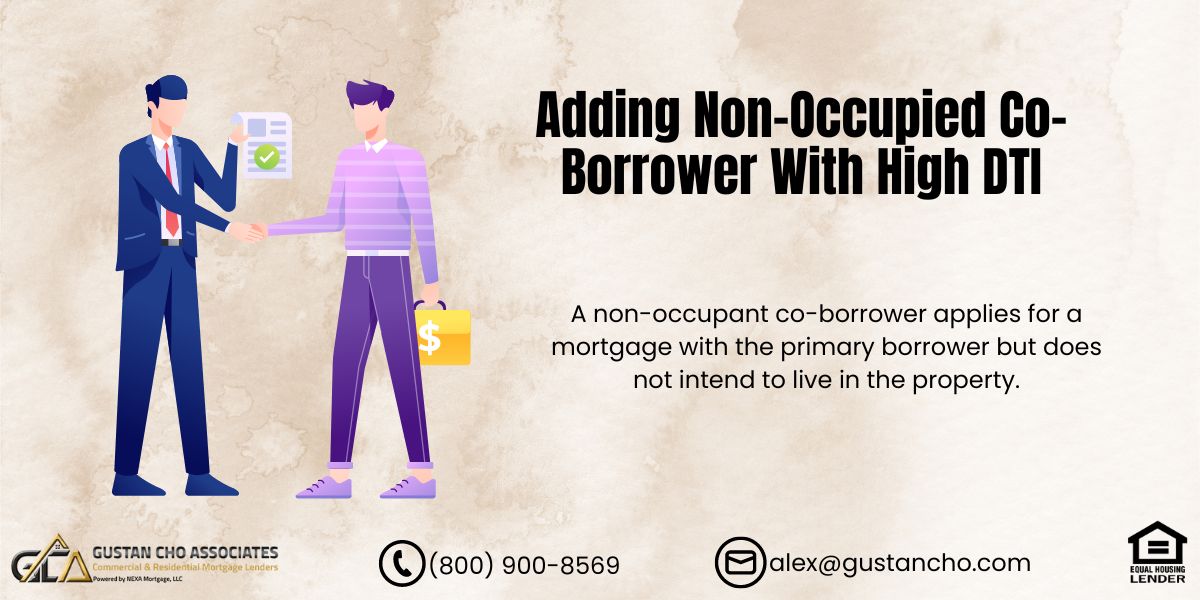This Article Is About Non-Occupied Co-Borrower Can Be Added To Borrower With High DTI
A large percentage of mortgage borrowers consult with Gustan Cho Associates Mortgage Group due to having higher debt-to-income ratios. Most mortgage lenders have lender overlays on debt to income ratios. Lender Overlays are mortgage guid+++elines that are above and beyond federal guidelines. Many lenders will have lender overlays on debt to income ratio. This holds true even though the borrower gets an approve/eligible per automated underwriting system with higher debt to income ratio.
Using non-occupant co-borrowers for those with high debt to income ratios.
Who Can be a Non-Occupant Co-Borrower?
A non-occupant co-borrower typically applies for a mortgage alongside the primary borrower but does not plan to live in the property. This co-borrower is frequently utilized to assist the main borrower in meeting the loan requirements by enhancing their overall financial and credit position. Some common examples of non-occupant co-borrowers include:
- Parents or Family Members: Parents often act as non-occupant co-borrowers for their children, especially first-time home buyers who might need help qualifying for a mortgage.
- Friends: A co-borrower must have a stable income and good credit history, and both parties must understand the legal and financial responsibilities involved.
- Business Partners: In some cases, business partners may co-sign a mortgage for a property intended for investment purposes.
- Significant Others: Unmarried couples or significant others might choose one person to live in the home while both are on the mortgage.
Fannie Mae and Freddie Mac do not require a higher down payment on a home purchase if you add non-occupant co-borrowers that are not related by law, marriage, blood to the homebuyer.
Lenders generally require non-occupant co-borrowers to have a close, demonstrable relationship with the primary borrower. Additionally, the non-occupant co-borrower’s credit history, income, and debts are considered during the loan approval process just as they are for the occupant borrower. This can impact the terms of the loan and the approval process itself. Speak With Our Loan Officer for mortgage Loans
Adding Non-Occupant Co-Borrowers To The Homebuyer
Borrowers can have zero income as the borrower (self-employed borrowers) and can qualify by adding non-occupant co-borrowers:
- If the non-occupied co-borrower has enough income to qualify for a mortgage loan, the deal can still be done
- Social security income, pension income, retirement income, alimony income, child support income, royalty income, all can be used as income in mortgage qualification
- Non-Occupant Co-Borrowers need to be related to the borrower by blood, marriage, law with FHA Loans
Conventional loans do not require non-occupant co-borrowers to be related to the main borrower.
Risks And Hesitancy With Non-Occupied Co-Borrower
Often times, a non-occupied co-borrower is reluctant in being a non-occupied co-borrower. This is because they feel that the mortgage will deter them from getting a mortgage of their own in the near future. The good news is that as long as the non-occupied co-borrower can qualify for another mortgage.
Non-Occupied Co-Borrower need to provide proof that he or she is a non-occupied co-borrower and not liable for making payments. They need to prove that they are not making the mortgage payments and someone else is.
Co-Borrowers need to provide proof that the mortgage payments have been made timely by the primary borrower via providing canceled checks and/or bank statements from the primary borrower
Again, it will not affect the non-occupied co-borrower after the primary borrower has had the loan for the past 12 months.
Debt To Income Ratio For Conventional Loans
Conventional loans are capped at much lower caps debt to income ratios than FHA and VA Loans. Conventional Loans are capped at 50% debt to income ratios if the borrower can get an approve/eligible per automated underwriting system. Most private mortgage insurance companies will not take on a borrower with higher than 45% DTI if they do not have at least a 680 credit score.
USDA Loans have much lower debt to income ratio caps at 31% front end DTI and a 41% back-end DTI. VA loans do not have a maximum debt to income ratio as long as the borrower can get an approve/eligible per automated underwriting system (AUS).
Both Fannie Mae and Freddie Mac do allow for a non-occupied co-borrower. Fannie and Freddie do not require non-occupant co-borrowers to be related to the main borrower by law, marriage, blood-like HUD does. HUD requires non-occupant co-borrowers to be related to the main borrower by blood, law, marriage for a 3.5% down payment home purchase FHA loan. If the non-occupant co-borrower is not related to the main borrower by law, blood, marriage, then a 25% down payment is required. Click here to apply for Conventional Loans
What is the Maximum LTV for Non-occupant Co-borrower?
The maximum loan-to-value (LTV) ratio for a mortgage involving a non-occupant co-borrower can vary depending on the lender and the specific loan program. Here are some general guidelines for common types of loans:
- Conventional Loans: The maximum LTV ratio for conventional loans not backed by the federal government can often be up to 95%. This means the borrower needs to provide at least a 5% down payment. Some lenders might require a lower LTV if the loan is considered higher risk.
- FHA Loans: The Federal Housing Administration (FHA) allows non-occupant co-borrowers to be part of the loan and typically permits an LTV ratio of up to 96.5%. It also allows for a down payment of as little as 3.5%. FHA loans are popular due to their lower credit score requirements and down payment options.
- VA Loans: The Department of Veterans Affairs does not have a strict loan-to-value (LTV) limit for loans it guarantees since it only guarantees a portion of the loan. However, non-occupant co-borrowers who are not spouses or are military-related might not be permitted under VA loans.
- USDA Loans: The United States Department of Agriculture (USDA) loans usually do not allow non-occupant co-borrowers unless they will also occupy the home. These loans often provide 100% financing (an LTV of 100%).
The exact LTV ratio allowed can also depend on factors like the credit scores of occupant and non-occupant co-borrowers, the property type, and the overall loan amount. It’s important to check with specific lenders or a mortgage broker to understand the applicable LTV ratios for a loan with a non-occupant co-borrower.
Can you Add a Co-Borrower to an Existing Mortgage?

Adding a co-borrower to an existing mortgage typically requires refinancing your current mortgage, which means replacing your existing mortgage with a new one that includes the additional co-borrower.
During this process, the original borrower and the new co-borrower must undergo credit and income checks to determine their eligibility under current lending standards. This might lead to more favorable loan terms, such as a lower interest rate or a higher loan amount, especially if the co-borrower has a strong financial background.
However, it’s important to consider that refinancing comes with closing costs, including loan origination fees and appraisal costs, similar to those encountered with the original mortgage. All parties should also understand the legal implications of joint homeownership, including responsibilities for loan repayment and property rights.
Since not all lenders allow adding a co-borrower to an existing mortgage, it’s crucial to check with your lender. If refinancing isn’t suitable, other options like loan assumption or modifying the loan terms with your lender could be explored, though these are less common and have specific requirements.
It is recommended to consult with a mortgage professional like Gustan Cho Associates to fully understand the implications and ensure the best approach.
Two Tradelines That Affect Debt To Income Ratio
Two of the most common tradelines that affect Debt To Income Ratios are the following:
- Car Loans
- Student Loans
Car Loans normally have higher monthly payments than any other credit payments due to the short amortization schedule.
- Student Loans have higher monthly payments due to large balance amounts.
- Many student loans are like home loans.
- Deferred Student Loans are no longer exempt from FHA Loans.
VA Loans allows deferred student loans that have been exempted from debt to income ratio qualifications on deferred student loans that have been deferred longer than 12 months. Click here to apply for mortgage loan with us
Overlays By Lenders On Debt To Income Ratio
Example of mortgage lender guidelines on debt to income ratios:
- To get an approve/eligible per Automated Underwriting System on FHA Loans, borrowers with 620 or higher credit scores can have up to 56.9% debt to income ratios
- However, most lenders will have a cap on debt to income ratios of 45% to 50% DTI
- The lower debt to income ratios required by individual lenders is called overlays
- Gustan Cho Associates has no overlays on government and/or conventional loans
We just go off approve/eligible AUS Findings on all of our government and conventional loan programs.
How Mortgage Underwriters Calculate Income And Debt To Income Ratio
Income and liabilities play a major role in qualifying for a mortgage loan. One of the most important factors besides credit scores is debt to income ratios. Debt to income ratios are calculated by taking total monthly expenses divided by total monthly income.
Types Of Debt To Income Ratios
There are two types of debt to income ratios:
- The first type of debt to income ratio is the front end debt to income ratios
- The front debt to income ratio is also called the housing debt to income ratios
- The second is the back end debt to income ratios which is also known as the total debt to income ratios
Front End Debt To Income Ratio
The front-end debt to income ratio is the sum of the principal, interest, property taxes, homeowners insurance, and homeowners association fees if any divided by the borrower’s total monthly gross income. The back end debt to income ratios is the sum of the borrower’s total monthly expenses which included the housing expenses, automobile loans, student loans, installment loans, revolving debts divided by the borrower’s total monthly gross income.
For FHA loans, the maximum allowable debt to income ratios for the front end is capped at 46.9%:
- the back end is capped at 56.9% in order to get an approved/eligible per DU Findings
- Borrowers who go over the maximum front end and back end debt to income ratio caps as a borrower, will not get an approved eligible by AUS (Automated Underwriting System)
One solution to qualify for mortgages with higher debt to income ratios is to get a non-occupied co-borrower to qualify for a mortgage loan. Qualify for mortgage with higher debt
FAQ About Non-Occupied Co-Borrower Can Be Added To Borrower With High DTI
- What is a non-occupant co-borrower? A non-occupant co-borrower applies for a mortgage with the primary borrower but does not intend to live in the property. This type of co-borrower is often used to assist the main borrower in meeting loan qualifications by improving the overall financial and credit profile. Examples include parents, family members, friends, business partners, and significant others.
- Why add a non-occupant co-borrower? Adding a non-occupant co-borrower benefits primary borrowers with high debt-to-income (DTI) ratios. Mortgage lenders often have strict DTI requirements, and having a co-borrower with a solid financial standing can help meet these requirements.
- Can a non-occupant co-borrower be related to the borrower? FHA loans require non-occupant co-borrowers to be related to the borrower to qualify for a 3.5% down payment. If not, a 25% down payment is required. Fannie Mae and Freddie Mac conventional loans do not have such requirements, and co-borrowers do not need to be related.
- What are the maximum LTV ratios for loans with a non-occupant co-borrower? Maximum LTV ratios vary by loan type. Conventional loans may allow up to 95% LTV, FHA loans up to 96.5%, and USDA and VA loans potentially up to 100%, depending on specific qualifications and lender guidelines.
- Can you add a co-borrower to an existing mortgage? Adding a co-borrower to an existing mortgage typically requires refinancing the mortgage into a new loan that includes the new co-borrower. This process involves credit and income checks and may result in different loan terms based on the new financial information provided.
- What are the financial implications of adding a non-occupant co-borrower? The primary borrower and the co-borrower must be aware of the legal and financial responsibilities involved, including the impact on credit and the ability to qualify for future loans. For instance, the non-occupant co-borrower must show they are not responsible for payments to exclude the debt from their DTI ratio in future loan applications.
- Are there specific lenders that do not require DTI overlays? Yes, some lenders, like Gustan Cho Associates, do not have overlays on government and conventional loans and assess qualifications based solely on the findings from an Automated Underwriting System (AUS), potentially allowing higher DTI ratios.
- What should be considered before refinancing to add a co-borrower? Before refinancing, consider the closing costs, the potential change in interest rates, and the legal implications of joint homeownership. It’s also essential to consult with mortgage professionals to ensure the best financial strategy.
This FAQ is designed to guide those considering the addition of a non-occupant co-borrower, especially in situations where the primary borrower’s DTI is high and may otherwise hinder mortgage approval.
If you have further questions about Adding Non-Occupied Co-Borrower With High DTI or you need to qualify for loans with a lender with no overlays, please contact us at 800-900-8569. Text us for a faster response. Or email us at alex@gustancho.com. The team at Gustan Cho Associates is available 7 days a week, on evenings, weekends, and holidays.
This blog about the Adding Non-Occupied Co-Borrower With High DTI was updated on May 2nd, 2024.
Related> Non-Occupant Co-Borrowers: FHA Loans
Related> Can I Qualify For Conventional Loan With Non-Occupant Co-Borrower?









You have a typo,
it says “Both Fannie Mae and Freddie Mac do not allow for a non-occupied co-borrower.” Except later on in the article, you make it clear that both DO allow a non occupied Co-borrower
Thank you. I have corrected it.